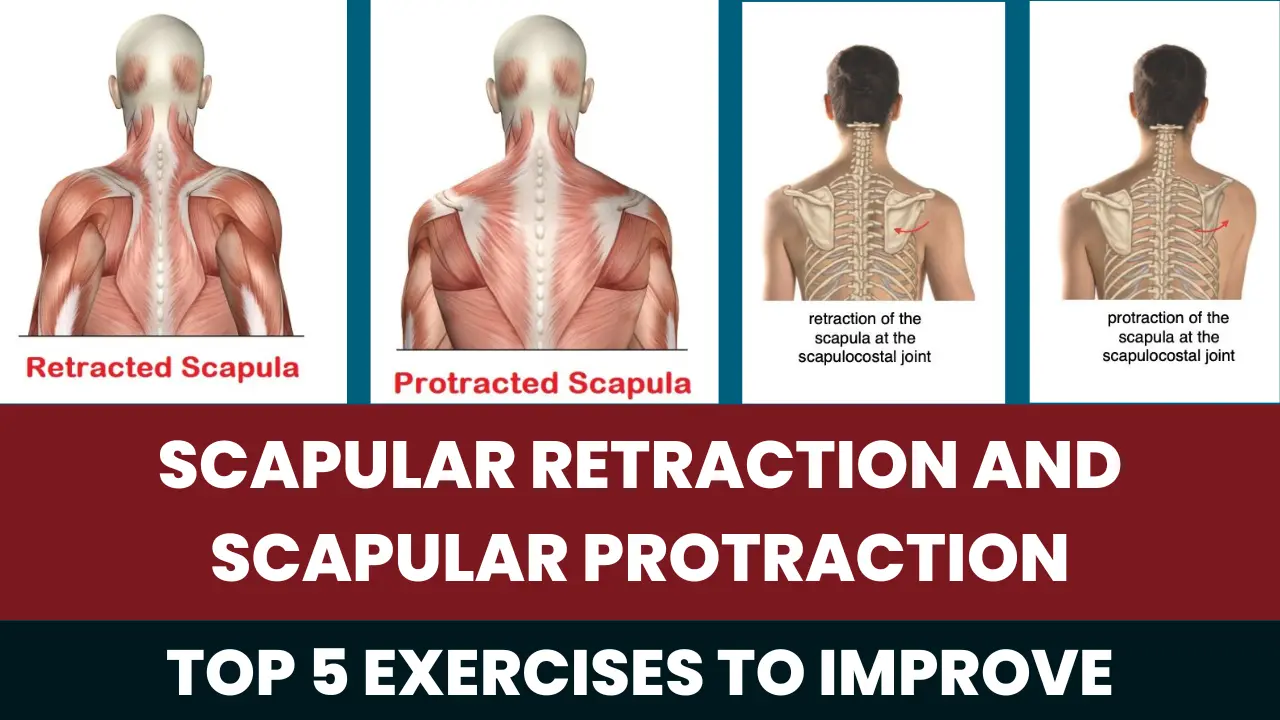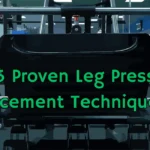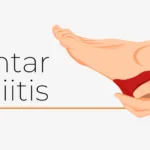Introduction
Understanding scapular movement and implementing focused exercises can have a profound impact on shoulder health and function. This article will provide a comprehensive overview of scapular retraction versus protraction, why improving strength and control in these movements matters, and the top 5 most effective exercises to target based on the latest scientific evidence and expert consensus.
Do read the People Also Ask (FAQs) about this topic.
Key Takeaways
- The scapulae (shoulder blades) play a crucial role in upper body movement and health. Proper scapular mobility with balanced retraction and protraction allows for a full shoulder range of motion.
- Scapular retraction slides the shoulder blades backwards and together using muscles like the rhomboids and mid-trapezius. Protraction glides the shoulder blades forward and apart using muscles like the serratus anterior.
- 5 highly effective exercises to improve scapular mobility are:
- Scapular wall slides (teach basic retraction/protraction control)
- I, Y, T, W sequence (target rotator cuff and scapular stabilizers through full range of motion)
- Prone cobras (integrate full scapular movement with upper extremity elevation)
- Low rows (build strength in scapular retractors – rhomboids, mid-traps)
- Wall slides with rows (combine mobility with strength training)
- Consistently performing exercises that facilitate balanced scapular motion is key for healthy posture, injury resilience, optimized sports performance potential, and shoulder joint function.
- Even small improvements in scapular function can make a big difference in preventing common shoulder, neck and back issues by enhancing this often overlooked area of upper body movement and stability.
Before diving into the best exercises, it’s important to clearly define what is meant by scapular retraction and protraction.
What is Scapular Retraction?
Scapular retraction refers specifically to drawing the shoulder blades straight backwards toward the spine. It is the opposite motion from scapular protraction.
When you retract the scapulae, you are contracting the muscles that connect the inner borders of the shoulder blades to the thoracic spine. The main muscles involved in scapular retraction include:
- Rhomboids (major and minor)
- Middle fibres of trapezius
- Levator scapulae
As these muscles activate to pull the scapulae back and together, the posture of the upper back and shoulders flattens, widening through the collarbones. Retraction provides stability for the shoulder joints.
What is Scapular Protraction?
Scapular protraction is the motion of sliding the shoulder blades forward around the rib cage, moving them farther apart. It is the opposite of scapular retraction.
The muscles that produce this action are mainly the serratus anterior and pectoralis minor. As they contract concentrically, the inner scapular border disconnects from the thoracic spine as the shoulder blades glide forward and around the ribs.
Protraction positions the glenoid fossa of the scapulae forward for better arm mobility in front of the body. This action also stretches the muscles of the mid-back.
Balanced flexibility through both scapular retraction and protraction allows full shoulder blade mobility important for upper extremity function.
The Top 5 Exercises to Improve Scapular Retraction and Protraction
Integrating even a simple scapular-focused exercise into your routine can pay dividends over time. But what are the best evidence-backed options?
Here are 5 exercises rated highly effective for enhancing scapular retraction and protraction strength based on scientific research and expert opinion from physical therapists, trainers, and sports medicine professionals.
- Scapular Wall Slides
- I, Y, T, W’s
- Prone Cobras
- Low Rows
- Wall Slide with Row
1. Scapular Wall Slides
Scapular wall slides are a beginner exercise that teaches basic scapular retraction and protraction control while flattening the upper back. This exercise is commonly used in shoulder rehab programs.
To perform scapular wall slides:
- Stand with your back flat against a wall, feet shoulder-width apart a few inches from the wall. The head and sacrum should maintain contact with the wall.
- Raise the arms over the head to place the back of the hands and forearms flush against the wall in a “Y” shape. Elbows should be straight.
- Initiate movement by depressing and retracting the shoulder blades down and toward the spine, flattening the upper back fully into the wall without raising the shoulders toward the ears.
- From the fully retracted position, slowly protract the scapulae by sliding the forearms up the wall until a stretch is felt in the shoulder blades. Do not let the lower back arch.
- In a controlled motion, slide the forearms back down into full scapular retraction against the wall.
- Repeat for 10-15 reps.
This basic exercise teaches full scapular protraction and retraction in a protected range of motion while keeping the core and glutes engaged. Use it as a warm-up and focus on proper shoulder blade motion.
2. I, Y, T, W’s
The I, Y, T, W exercise sequence targets strength through full scapulohumeral movement. Named for the shapes made with the arms, these are Rotator Cuff and scapular stabilizer exercises commonly prescribed in physical therapy.
Start by lying face down on a bench or exercise ball with arms extended straight out to the sides and thumbs up, forming an “I” shape. From here, move into each letter shape:
I – Scapular adduction
- With arms straight out sideways at shoulder level, initiate the movement by squeezing the shoulder blades down and in toward the spine using mid/lower traps and rhomboids. Aim to feel shoulder blades flatten and draw together without pinching shoulders up.
Y – Scapular retraction
- From the “I” position, raise arms in a “Y” overhead at less than 90 degrees with a focus on shoulder blades retracting down and back as arms elevate. Use lower/mid traps to keep shoulder blades connected to the rib cage.
T – Scapular protraction
- From overhead “Y”, opens arms sideways into a “T” by protracting the shoulder blades forward and outward around the rib cage. Use serratus anterior to initiate the slide of shoulder blades around ribs without elevating shoulders toward ears.
W – Scapular depression
- From the “T” position, flip palms forward and sweep arms back down to the straight arm “I” position while depressing shoulders down away from ears using mid/lower traps. Lightly pinch shoulder blades together at the bottom without hyperextending the lower back to complete movement.
Perform 2-3 sets of 10-15 controlled reps for improved serratus anterior and trapezius strength through full scapular motion. Maintain neck neutral and relax head throughout each sequence.
3. Prone Cobras
The prone cobra exercise strengthens the upper back while integrating full scapular movement into upper extremity elevation. It challenges stabilization muscles along the shoulder blades.
To perform cobras properly:
- Lie face down with palms facing down under shoulders and tops of feet on the floor. Engage the core gently without hyperextending the lower back.
- Contract mid/lower traps to draw shoulder blades gently together and flatten the upper back into the floor. Initiate all movement from here with shoulder blades.
- With control, glide shoulder blades down the spine as you extend your arms straight by protracting shoulder blades and lifting your chest slightly off the floor. Arms remain straight with glutes and thighs relaxed on the floor.
- From the extended position, smoothly retract shoulder blades to lower back down with control. Move through a full range of protraction and retraction available without strain.
- Repeat 10-15 times focusing on quality of scapular movement integrated with upper extremity elevation.
This prone exercise strengthens the serratus anterior and lower traps using the shoulder blades to elevate the upper body. Keep reps smooth and controlled.
4. Low Rows
The bent-over row exercise builds strength in the scapular retractors, including mid-traps, rhomboids and lats. Use low cable rows or dumbbell rows.
To perform rows for improved scapular strength:
- Stand with knees slightly bent holding handles attached to low cable/dumbbells with arms extended. Hinge at hips to bend the torso forward 45-60°, keeping back straight.
- Engage core muscles gently and draw shoulders down away from ears and together to stabilize shoulder blades – this is the start position.
- Initiate the movement by drawing elbows up and back, squeezing shoulder blades toward the spine to feel the mid-trap contraction. Lead with retracting scapulae, not arms.
- From a fully retracted position (elbows at ribcage height), control return motion to straight arm position to complete one rep.
- Complete 2-3 sets of 10-15 reps with a focus on consistently stabilizing shoulder blade position and achieving full retraction each rep.
Proper rowing form initiated by scapular retraction trains muscular endurance important for posture and athletic strength. Maintain brace through the core without movement in the lower back/hips.
5. Wall Slide with Row
This exercise combines wall slides and bent-over rows to tie together scapular stability, mobility, protraction and retraction strength.
To perform the combo exercise:
- Stand facing the wall with feet under hips, knees soft. Place forearms flat on the wall at shoulder height.
- Depress and retract shoulder blades flatten into the wall without hiking shoulders up.
- Maintaining a flat back, hinge slightly forward at the hips to feel tension increase in upper back muscles.
- Protract shoulder blades smoothly along the chest wall. Slide forearms overhead toward the ceiling to feel stretch across the chest.
- From the overhead position, squeeze shoulder blades to the sides and down into retraction as you simultaneously row elbows back behind the torso. Focus on rhomboid, mid-trap and lat tension drawing forearms/elbows back.
- Slide arms overhead into the finish position before repeating.
- Perform 2-3 sets of 8-12 reps with a focus on consistent, quality scapular movement and integrated rowing. Maintain stable spinal alignment.
This challenging exercise coordinates full shoulder blade mobility with rear shoulder strength for functional stability. Use slower tempos and lighter loads first.
Be sure to keep a good upright posture, engage your core, and avoid excessive arching or twisting movements with all exercises. Focus on quality contraction in your target area rather than just moving the load.
If unsure about proper form or technique, work with a certified trainer or physical therapist to ensure effectiveness and safety.
Scapular Exercises for Healthy Shoulders
Regular practice combining mobility, strength and proper movement pattern reinforcement ensures the healthy function of the scapulae and shoulders. These top 5 exercises can improve posture flaws, enhance sports performance potential, prevent injury or expedite shoulder rehab by targeting key supportive musculature and motor control.
The proper scapular function is not always felt, but impairment contributes to many common shoulder, neck and back issues. By using these fundamental, research-backed exercises that integrate scapular control into upper body movement, you’ll feel – and move – better.
Why Improve Scapular Retraction and Protraction Strength?
Letting your scapulae “wing” or tip forward away from a retracted position can overstretch tissues over time and contribute to shoulder impingement, rotator cuff tendinitis, postural imbalance, and altered mechanics that raise injury risk.
Alternatively, the inability to protract sufficiently can limit overhead reach like during a tennis serve or swim stroke. It also reduces the extension range of motion important for pec and anterior shoulder flexibility.
Strengthening the scapular retractors and protractors better engages these smaller stabilization muscles to keep the shoulder blades firmly against the thorax. This provides a solid base from which larger movers of the shoulder and arms can function optimally with reduced compensation and impingement.
In short, improving control of scapular position builds a stronger “foundation” for upper body movement and health.
Scapular Anatomy and Biomechanics
Now, let’s review some key scapular anatomy and biomechanics:
- The scapulae are triangle-shaped bones that connect the arms to the clavicles and ribcage. Along with the clavicles, they make up the shoulder girdle.
- Scapular motion is controlled by muscles attaching the shoulder blades to the ribs and spine. The key muscles involved are the trapezius, serratus anterior, rhomboids, and levator scapulae.
- The scapulae slide along the ribcage in protraction and retraction. They also tilt and rotate. Full scapulohumeral rhythm requires a balance between mobility and stability.
- Retraction moves the scapulae backwards and closer together, facilitated by the trapezius and rhomboids. Protraction slides the scapulae forward and apart, using the serratus anterior.
- Balanced strength and flexibility in all scapular movers are necessary for optimal shoulder function, injury resilience, posture, and sports performance.
Conclusion
Regularly incorporating focused scapular stability exercises builds a critical foundation for upper body durability, performance, and reduced injury risk. An ounce of prevention through simple moves like the rows, slides, presses, pulls and raises described here can prevent a pound of shoulder problems down the road!
Commit just 10-15 minutes 2-3x a week to one or a combination of these top five exercises and you’re sure to notice the benefits over time. Healthier shoulders and happier arms and activities await!
People Also Ask (FAQs)
Q) Protraction and retraction anatomy
A) The main muscles involved in scapular protraction are the serratus anterior and pectoralis minor which slide the shoulder blades forward around the rib cage. Scapular retraction uses the rhomboids, mid-trapezius, and levator scapulae to draw the shoulder blades backwards.
Q) Protraction and retraction of jaw
A) Jaw protraction slides the jaw forward, commonly called an underbite. Jaw retraction draws the jaw backwards into proper alignment, correcting the underbite. These motions occur at the temporomandibular joint (TMJ).
Q) Protraction and retraction examples
A) Examples of scapular protraction include an overhead tennis serve or pushing motion. Examples of scapular retraction include pulling motions like rowing or band pull-apart.
Q) Protraction and retraction exercises
A) Good exercises targeting scapular mobility are wall slides, YWTLs, prone cobras, rows, and wall slides with row combinations. These improve strength and neuromuscular control through full shoulder blade movement.
Q) Protraction and retraction movement
A) Protraction is the action of sliding the shoulder blades forward and outward around the ribcage. Retraction draws the shoulder blades straight backwards toward the spine between the scapulae.
Q) Scapular protraction and retraction
A) Scapular protraction and retraction refer specifically to the shoulder blades sliding forward and backwards along the rib cage. Having a balance between these motions allows full upper extremity mobility.
Q) Protraction and retraction at temporomandibular joint
A) The temporomandibular joint connects the jaw bone to the skull. Protraction slides the jawbone forward, while retraction draws it backwards into proper alignment. Issues like underbites and overbites can result from an imbalance between these motions.
Q) Protraction of scapula
A) Scapular protraction occurs when the serratus anterior and pectoralis minor contract to slide the inner border of the shoulder blades away from the spine and around the rib cage. This increases clearance for arm mobility in front of the body.












